Reference of the picture: Decontamination Archive Site
Hello, everyone. My name is Daichi, an expert providing the information on the radiation issues in an easy-to-understand manner.
Today, I would like to respond to the following questions:
– How have the removed soil and waste arising from decontamination and other activities treated?
– How are the methodologies for the treatment of the soil and waste different between the Fukushima Prefecture and the other Prefectures?
Table of contents of this article
- Treatment of removed soil and waste arising from decontamination and other activities
- Kinds of soil and waste arising from decontamination activities
- Soil and waste arising from decontamination activities
- Waste arising from other than decontamination activities
- Treatment in the Fukushima Prefecture
- Treatment outside the Fukushima Prefecture
- Summary
I have been involved with the radiation-relevant issues, like the policy on the decontamination activities and the management of the Interim Storage Facility, after the accident of the Fukushima Daiichi Nuclear Power Plant in 2011.
I received a doctorate in the field of radiation, while working in Fukushima.
Treatment of removed soil and waste arising from decontamination and other activities
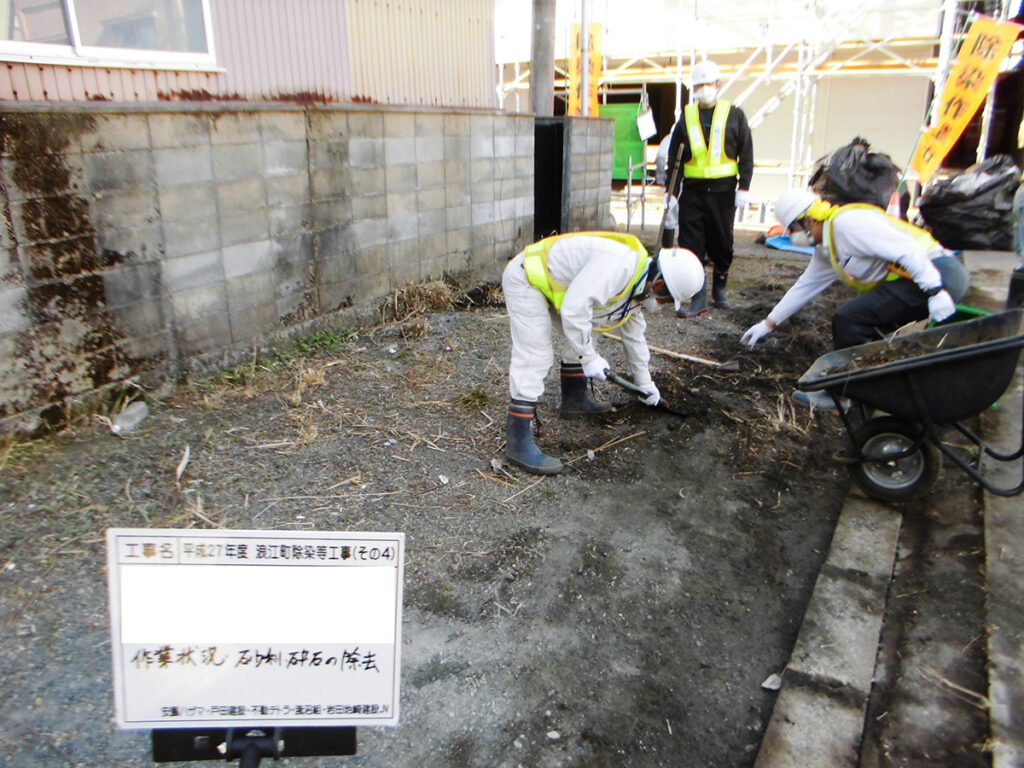
Reference of the picture: Decontamination Archive Site
Basically the soil and waste arising from decontamination activities are treated with the procedures of ‘transportation’, followed by ‘treatment (including intermediate treatment, storage)’ and ‘final disposal’, as done in the treatment of non-radioactive, normal waste.
These soil and waste, which have been generated in the aftermath of the accident of the Fukushima Daiichi Nuclear Power Plant, have been treated (or have been tried to be treated) in a different manner, because they include radioactive materials derived from the accident of the Nuclear Power Plant, not only from the viewpoint of science, but also of social acceptance, although radioactive concentration is much lower than the so-called ‘High level radioactive waste’, generated through operations of nuclear power plants.
The procedures for treatment of the soil and waste are different between that in Fukushima Prefecture and that in other Prefectures.
Therefore, they are explained individually in the following chapters.
Kinds of soil and waste arising from decontamination activities
First of all, the act, which has provided the decontamination activities with legal ground for their implementation, distinguishes soil and waste generated through decontamination activities, and waste generated through activities other than decontamination activities, which are both activities to address environmental contamination caused by radioactive materials released after the accident of the Fukushima Daiichi Nuclear Power Plants.
The act: The Act on Special Measures concerning the Handling of Environment Pollution by Radioactive Materials
Official name: The Act on Special Measures concerning the Handling of Environment Pollution by Radioactive Materials Discharged by the NPS Accident Associated with the Tohoku District – Off the Pacific Ocean Earthquake That Occurred on March 11, 2011)(in Japanese)
Soil and waste arising from decontamination activities
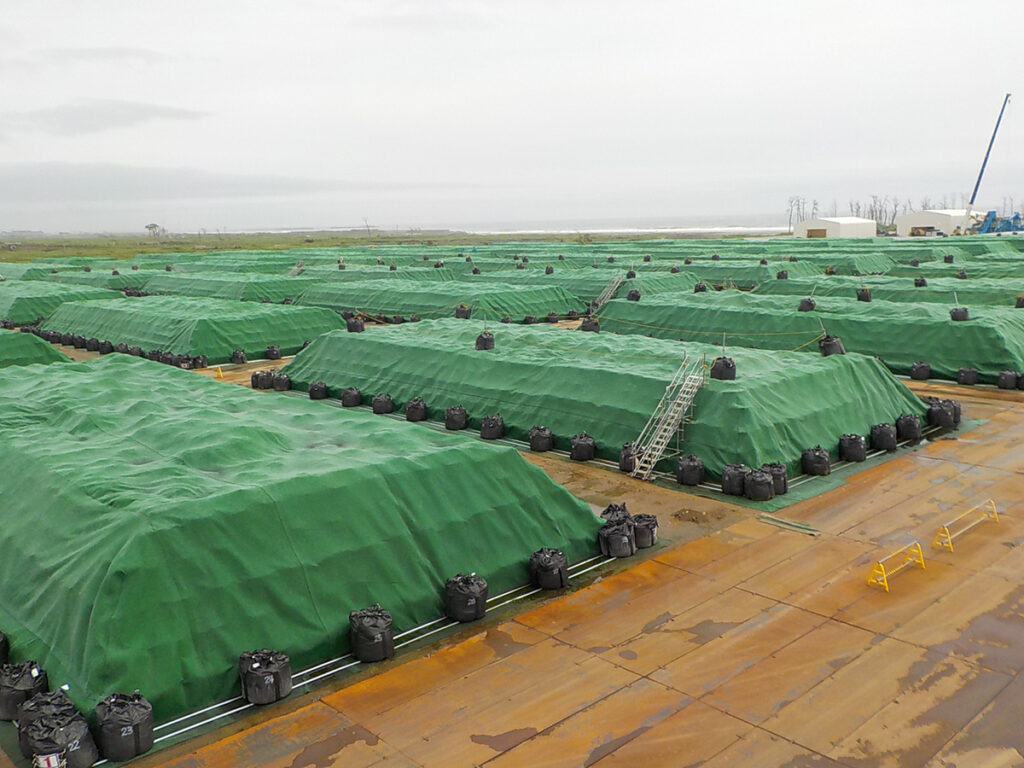
Reference of the picture: Decontamination Archive Site
Among the soil and waste mentioned above, those generated through decontamination activities basically contain 2 kinds of things: ‘soil’ and ‘burnable waste like grasses and leaves’, because specific operations of decontamination activities are, for example, scratching off top soil, mowing weeds, removal of branches and leaves on the surface of forests.
Basically, other kinds of waste like large debris would not be generated as a result of decontamination activities.
In addition, ‘soil’ and ‘waste’ are also legally distinguished.
This concept is consistent with all kinds of Japanese laws, including not only the Act on Special Measures concerning the Handling of Environment Pollution by Radioactive Materials, but also the Waste Management and Public Cleansing Law, although soil could be regarded as waste, when it turns into sludge.
Waste arising from other than decontamination activities
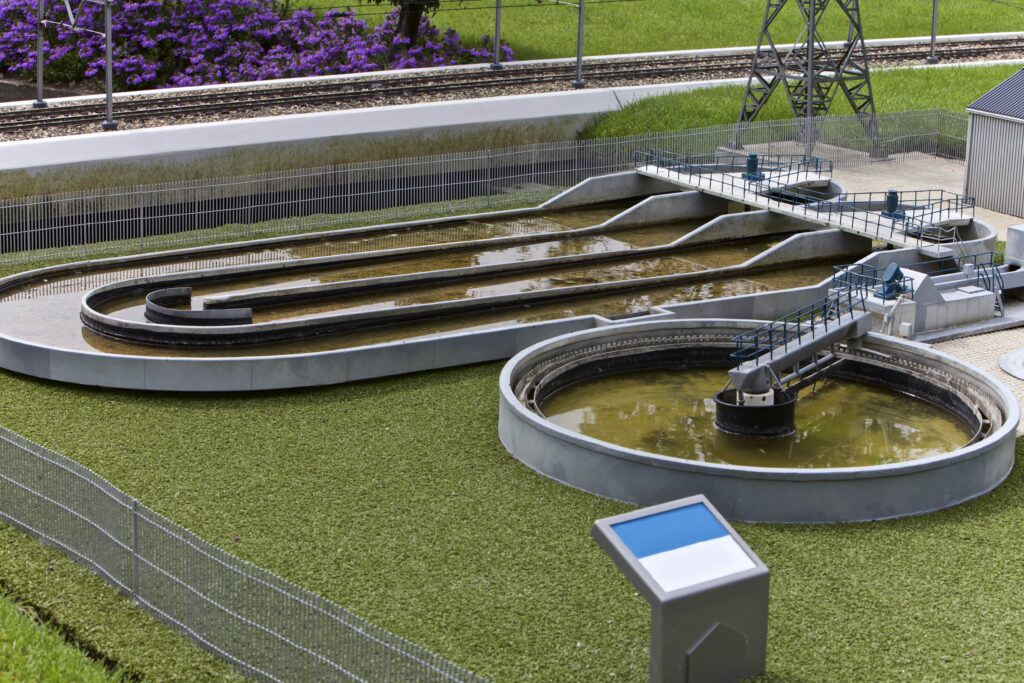
On the other hand, radioactive waste is sometimes generated, as a result of activities other than decontamination activities (e.g.: incineration of waste, waste water treatment).
These waste is called the ‘Specified Waste’, and categorized into 2 kinds of waste, the ‘Designated Waste’ and the ‘Waste in the Countermeasure Areas’ and they are defined collectively as the ‘Specified Waste’, in the Act on Special Measures concerning the Handling of Environment Pollution by Radioactive Materials.
The ‘Designated Waste’ is waste with more than 8,000Bq/kg and designated by the Minister of the Environment, and the ‘Waste in the Countermeasure Areas’ is the waste generated in the Countermeasure Areas (The Specified Waste is elaborated in this article).
Treatment in Fukushima Prefecture
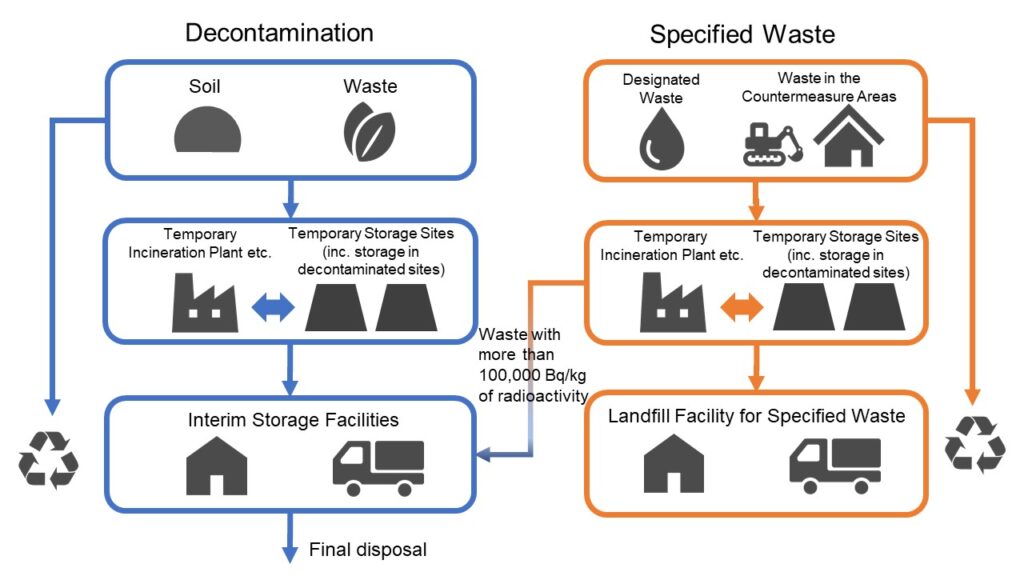
As aforementioned, treatment procedures of removed soil and waste arising from decontamination and other activities are different between that of within the Fukushima Prefecture and outside the Fukushima Prefecture, therefore they will be explained individually.
Regarding the specific procedures within the Fukushima Prefecture, it is shown in the above figure, although this is the very basic flow and there are different flows for the soil and waste to be treated.
First of all, removed soil and waste are transported to Temporary Storage Sites for their storage, or to Temporary Incineration Plants for their volume reduction.
In case the Temporary Storage Sites can’t be secured, for some reason, they are sometimes temporarily stored in the decontaminated sites, before the construction of the Temporary Storage Sites.
This was not the case in the Special Decontamination Areas, because in principle decontamination activities were implemented after the construction of the Temporary Storage Sites.
On the other hand, in the Intensive Contamination Survey Areas, especially in the urban areas, it was very difficult to secure the Temporary Storage Sites and there were a lot of cases, that soil and waste were stored at the decontaminated sites for a long time (regarding the Special Decontamination Areas and the Intensive Contamination Survey Areas, please visit this article).
After that the soil and waste are supposed to be transported to the Interim Storage Facilities and stored until they are brought there for their final disposal.
The Interim Storage Facilities are temporary storage facilities, as its name represents, and soil and waste stored in these facilities are supposed to be disposed outside Fukushima Prefecture within 30 years from the start of the interim storage (For more information about the Interim Storage Facilities, please visit this article, this article, this article and this article.).
Part of the soil and waste has been recycled through demonstration projects, but it has not come to the step for large-scale projects (this recycling issue will be also covered in another article).
Regarding the Specified Waste, it is treated almost in a same manner.
One of the points, a little bit different from soil and waste arising from the decontamination activities, are the fact that waste with more than 100,000Bq/kg of radioactivity is supposed to be stored in the Interim Storage Facilities, as a result of assessment of structure of facilities and radiation dose.
The second point is, that there are 2 facilities (not for interim storage, but) for final disposal of the Specified Waste in the Fukushima Prefecture (For more detailed information about the Landfill Facilities for the Specified Waste, please visit this article, this article and this article.).
Part of the Specified Waste has been already recycled.
Treatment outside Fukushima Prefecture
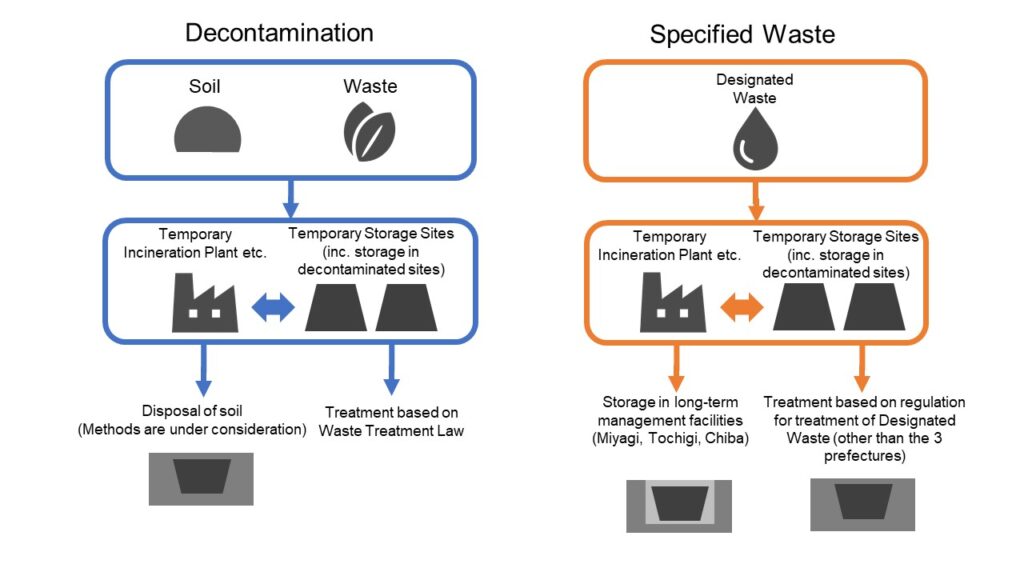
Treatment flow of soil and waste in other than the Fukushima Prefecture is shown in the above figure.
This is, however, a basic material flow and there are other treatment flows.
First of all, soil and waste arising from the decontamination activities, are transported into the Temporary Storage Sites or/and incinerated and their volume is reduced in the temporary incineration facilities, as is the case with in Fukushima Prefecture.
When the Temporary Storage Sites can not be secured, for some reasons, the soil and waste could be stored temporarily in the decontaminated sites, before the construction of the Temporary Storage Sites.
One of the major differences is that there are no facilities, like the Interim Storage Facilities, to manage the a large volume of soil and waste in an integrated manner.
One of the reasons for the absence of the facilities, is that the volume of soil and waste generated, is much smaller than within Fukushima Prefecture, due to the difference of methods for the decontamination.
Therefore, even now there are a lot of cases, that soil and waste are stored in the decontaminated sites (e.g.: residents, schools, parks), under the ground of premises.
Specific methodologies for their disposal, are under the consideration through demonstration projects.
Regarding waste other than soil, with less than 8,000Bq/kg of radioactivity, which is the value for the designation as the Designated Waste, is regarded as possible, to be treated based on the Waste Treatment Law like the other normal non-radioactive waste.
With regard to the Specified Waste, there are no waste categorized as the Waste in the Countermeasure Areas, because the Countermeasure Areas exist only in Fukushima Prefecture.
On the other hand, the Designated Waste is generated even outside Fukushima Prefecture, and it is managed in the site of its origin or in the other sites in an integrated manner, after the necessary volume reduction.
As a next step, in Miyagi, Tochigi and Chiba Prefectures, taking account of the shortage of storage spaces, the Designated Waste is supposed to be stored in the long-term storage facilities, but there are no prospects so far in every prefecture, for the detail survey for the candidate site.
Meanwhile the Designated Waste is managed by strengthening of storage system, or lift of designation of the waste, whose radioactivity decreases less than 8,000Bq/kg with the passage of time.
Summary
This article covers the treatment of removed soil and waste arising from decontamination and other activities, especially focusing on the categories of soil and waste, as well as difference of treatment procedures in the Fukushima Prefecture and the other prefectures.
The Specified Waste, the Landfill Facility for the Specified Waste, the Interim Storage Facilities and measure for recycling of removed soil, which are just briefly touched in this article, are covered in other articles, so please visit them for more detailed information.
By the way, above-mentioned contents are summarized in the following videos.
It would be appreciated to visit them at your convenience.
– Japanese version
– English version
You can read the same article in Japanese here.
Thank you very much for reading this article.
See you next time!
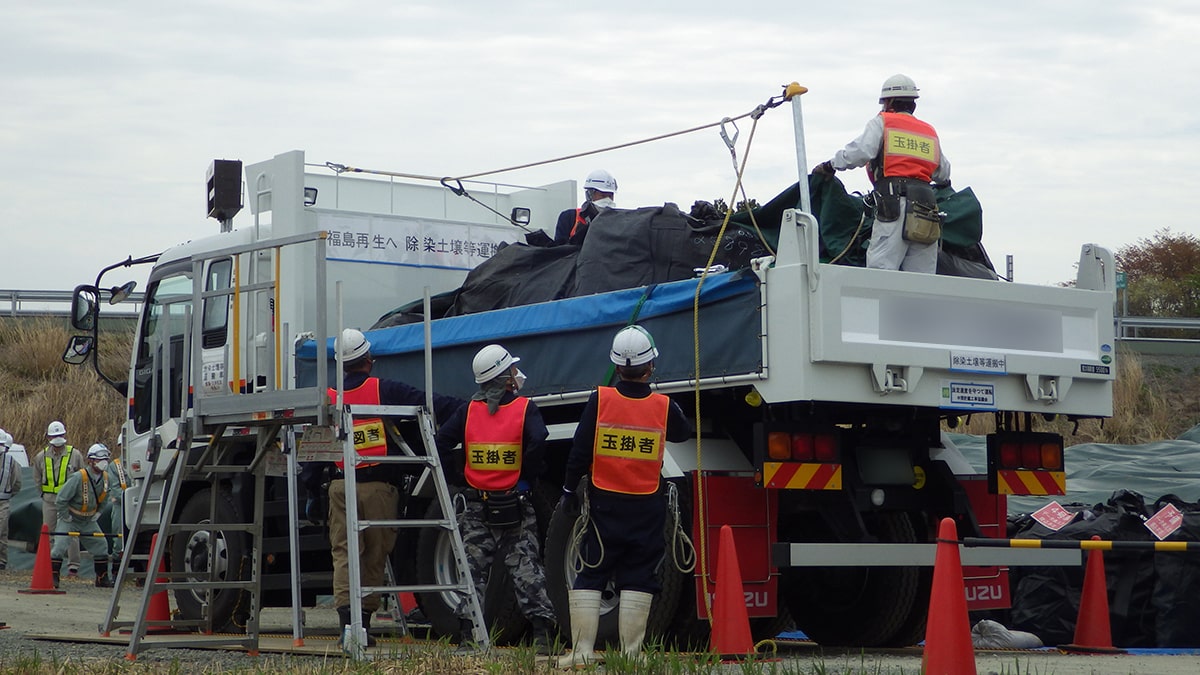


コメント